Hakata Ori 博多織

Hakata Ori, or hakata weave, is a stripe-like pattern common on obi and cords.
I adore this weave. I think it's so pretty; I've always been so attracted to hakata obi's, thus I've decided to do this little appreciation post.
I adore this weave. I think it's so pretty; I've always been so attracted to hakata obi's, thus I've decided to do this little appreciation post.
Instead of going through the effort to rewriting my own post, I've posted my research below from various sites (so some stuff is repeated). I'm sorry, but re-writing everything into original prose seams a bit daunting to me :P (in other words, I'm lazy).
------------------------------------------------------------------------------------------------------------------------
From Immortal Geisha (slightly edited for this blog post)
Hakata Ori
Named for the region of Hakata-ku, Fukuoka, where it is primarily woven, Hakata is a distinctive thick silk textile, used primarily for obi, but also found on other items where a stiffer textile is necessary, such as handbags, zori, and especially datejime, where it's prized for its stiff texture and ability to hold in place without slipping. Hakata silk is very tightly woven, giving an appearance similar to grosgrain ribbon. When it's being tied, it should have a very distinctive "squeaking" noise as the ridges rub up against each other. This is not a flaw - it is a sign of a good true Hakata weave.Other common terms for hakata include hon-chikuzen, honchiku, hakata-ori, and kenjo-gara, when referring to the typical geometric design.
Seasonal Use, Exceptions & Pairings
As hakata is generally displayed in the kenjo-gara design, it is considered seasonless. It is always prudent to keep in mind the weight of the fabric - ro hakata can only be used in the summer, fukuro-sewn hakata only in awase seasons, but hakata weave is by default hitoe, and as an exception these can be used nearly year-round.Hakata obi are available in all standard modern obi sizes - hanhaba, nagoya, and fukuro.
Motif Variations
Kenjo-Gara 献上柄
(see below for meanings for this motif)While black and white is by far the most common colour combination for hakata weave, it is available in a multitude of other variations, several of which represent the five elements in Chinese mythology, or the five virtues of Confucianism.[2]
- Purple - Righteousness
- Green - Benevolence
- Red (also pink) - Propriety
- Yellow - Trust
- Blue - Wisdom
- Auspicious Nature
Motif in Literature & Other Usage
Geisha
Hakata was generally considered too casual and too "drab" for the average woman. However, as is their style, Geisha turned something mundane into something profoundly iki. While still technically too casual for most women, Geisha, especially of the Hakata district, are known to wear hakata fukuro obi with even the most formal kurotomesode outfits. There are also many examples of hakata darari obi for maiko.
--------------------------------------------------------------------------------------------------------------------------
From http://www.shop-japan.co.jp/english-boku/kenjou.html, however I've expanded, edited, and added some stuff.
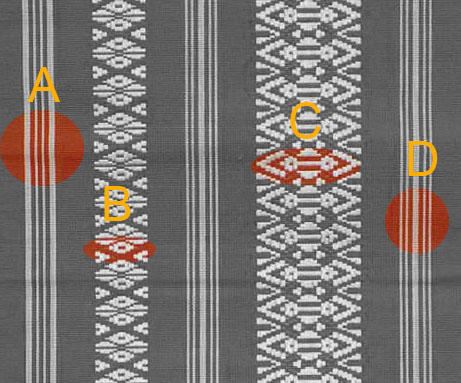
(source)
KENJOU 献上柄 design (shown above) is one of the most traditional design. It is originally from Hakata, Fukuoka Pref. in Kyushu, JAPAN.
Each woven stripe has a meaning:
A : Stripe (OYAKO JIMA = Parent and Child)
The thicker line is regarded as parent and thinner one is child.
"A" has thinner lines between thicker ones.
This means "parents are guarding their children"
B : Kaki (Hanadai or Hanazara)
This motif comes from Buddhist's prop. A flower base for Buddha and Hotokes.
You can see this line has roll- printing of the base.
華皿 はなざら (Hanazara)

C : Dokko
This is also Buddhist's prop motif. This is a prop Buddhist priest have.
This is also roll-printing design of the prop, Dokko.
独鈷 どっこ (Dokko)

D : Oyako Jima
This stripe is also Oyako jima, but see, this stripe means; children will guard their parents.
-------------------------------------------------------------------------------------------------------------------------------------------------------------
From JAPAN BLOG by AubergineFleur. Slightly edited for this blog post.All About Hakata Obi 博多帯のそれぞれ (英語で)
When someone refers to a Hakata obi 博多帯, usually what they mean is one specific weaving design of the Hakata obi called “kenjō” 独鈷, and also called “tokko” 独鈷, which resembles, and is so named for, the single-prong vajra Buddhist ritual implement, which looks kind of like <<=>>.

However there are many other designs woven into hakata obi, many floral rather than geometric, and the most ornate ones are prohibitively expensive.
* For more on the design and meaning see Bokunan-do's page on Kenjou Design.

“Hakata obi” is actually short for “hakata-ori no obi,” an obi of hakata weave. The Hakata obi is named for its place of origin in Fukuoka prefecture, where it is still woven today. The weaving technique was introduced to Japan the Katei era (1235-1238) by Mitsuda Yazaemon who went to Song-dynasty China and studied weaving techniques there. In its early period, it was a genuine form of Chinese weaving, referred to in Japan as “kara-ori” 唐織, “mainland-style weaving,” and was made of silk imported from China, although now the silk is produced in Japan.
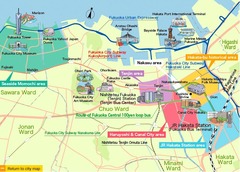
In 1600, the domain feudal lord, Kuroda Nagamasa, sent the Shogun as tribute hakata material in the kenjō design, and from thence on, the kenjō design became a hallmark of Hakata obi. The special quality of the hakata weave is the warp is used to make the design (unlike the Kyoto Nishijin weave 西陣織 which uses the weft), the threads are of varying thickness, and it makes a special silk noise called “kinu-nari” 絹鳴り. The silk material is also very firm and holds its shape well, so the tying of the bow of the obi does not come loose. Traditionally Hakata obi were hand-woven on a loom, but now they are often made on a jacquard loom, allowing for more gorgeous designs, some of which I believe are now computer generated.
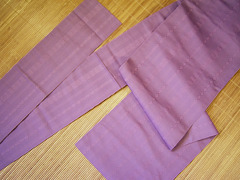
Hakata obi of the kenjō-tokko design are primarily made into a Nagoya obi or a hanhaba (half-width) size obi. Both may be either single-layered (hitoe) or double-layered (fukuro). There are also summer sha-gauze weaves in a kenjō-tokko design hakata obi, basically a loose weave, with a simple over-under pattern in the parts without design.
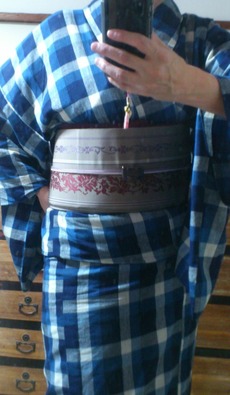 TPO for Hakata Obi TPO for Hakata Obi
Hakata obi of the kenjō design are fairly informal for the ordinary wearer. Based on observation, a Nagoya obi style can be worn with “fudangi” 普段着 everyday wear, everyday-wear tsumugi, and komon (simple all-over pattern kimono). An hanhaba hakata obi is even less formal, but can be worn with “fudangi” everyday wear, everyday-wear tsumugi, and yukatas.
<-- Mirror Image! 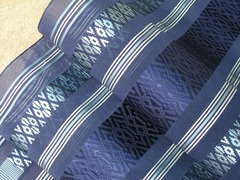
Sha-weave Nagoya hakata obi’s are often worn with ro-weave komon in the summer, and a sha-weave Hakata obi, whether Nagoya or hanhaba, dresses up a yukata. Maiko-san in Kyoto often wear sha-weave Hakata Nagoya obi’s with their yukatas in summer. One of my favorite Japanese bloggers on kimono wore a sha-gauze hakata Nagoya obi with her elegant Chikusen yukata last year, see Yukata Elegance: "Wa-bijin wo mezashite"
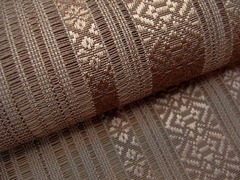
Likewise for the similar summer ra-gauze weave Hakata obi.
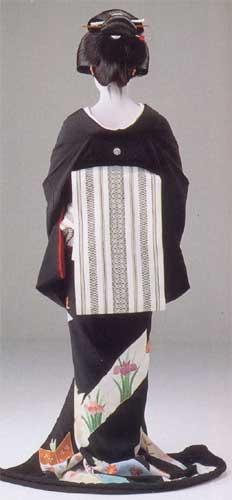
Hakata obi’s with the kenjō-tokko design are typically not worn with anything more formal than a komon, such as a tomesode, except by professionals such as Geiko-san (the Geisha of Kyoto), Japanese traditional-style dancers, and Noh performers. There are some extremely fancy hakata obi’s with a design other than kenjō-tokko that come in the formal fukuro-obi style. These are often worn with iro-muji kimonos.
Personally, I tend to wear kenjō-weave hakata obi’s (both hitoe and awase) often with yukata. This is because most of my hakata obi are the hanhaba size, so too informal to wear with much else. I do occasionally wear my non-kenjō design hanhaba hakata obi with my everyday-wear indigo tsumugi-kasuri kimono. I have become a bit of a Hakata-obi maniac, and have more than any sensible person needs. The one I wear most often is a dusty pinkish-purple (maroon) hassun Nagoya obi which I often wear with my indigo tsumugi-kasuri kimono, or just about anything else for that matter. As far as I can remember I only have two summer Hakata Nagoya obi, one is an egg-shell white sha-weave hakata obi which I wear with my summer ro komon or a high-end yukata, and another is a blue sha-weave hakata obi I wear with a high-end Chikusen yukata.
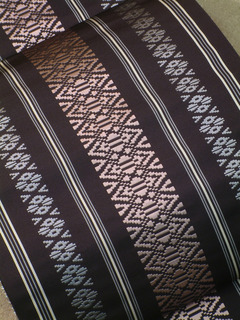 When to wear Hakata obi, seasonally –wise? When to wear Hakata obi, seasonally –wise?
Hakata obi’s are worn all year round. If you want to get really fancy, and have funds to buy the different types, you could wear a awase (double-layered) hakata obi with a awase (lined kimono) during the winter months from late September to early May, a hitoe (single-layer) hakata obi with a hitoe (unlined) kimono in the spring and fall months of mid-May to Mid-June and late August to late September, and a sha-gauze weave hakata obi with an “usumono” (sha, ro, hemp) kimono in the hottest part of summer from June to early September. Most hakata obi of the kenjō-tokko design, when made into a Nagoya obi, seem to typically be single-layer, and these in particular are often worn all year round, with the exception that the sha weave is only worn during the summer months. For more on what to wear when in general, see post “Kimono Seasons,” which has several kimono seasonal charts from kimono magazines.
-------------------------------------------------------------------------------------- Some Japanese information. I haven't translated it yet so I don't know if it's the same information as above. From here. 献上柄 |
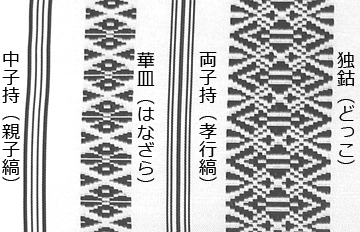
献上帯の謂れは古く、慶長5年(1600年)黒田長政が現在の福岡である筑前を領有するようになってから、毎年、幕府への献上品として博多織を送ったことに由来しています。献上柄は、一般に独鈷と華皿を文様化したもの、そして、その独鈷と華皿をそれぞれ両子持縞と中子持縞という2種類の縞柄によって挟んだ柄になっています。独鈷とは、仏像・不動明王などが手に持たれている仏具で、我々の悩みの元である煩悩を打ち砕くと伝えられています。華皿は、仏を供養する際の仏具で、華を盛る皿。縞柄は、太い線が親、細い線が子を現わしています。二人の子供を両親がかばうように囲んだ中子持縞は親子縞とも呼ばれ、一方、子供たちに囲まれ親に寄り添うように描かれた両子持縞は、孝行縞とも呼ばれています。幕府への忠誠を示し、神仏の御加護と家内安全・家内繁盛を願った縁起物として重宝されました。
----------------------------------------------------------------------------------------------------
Another Japanese link. "博多織について" here.
No comments:
Post a Comment
Note: Only a member of this blog may post a comment.